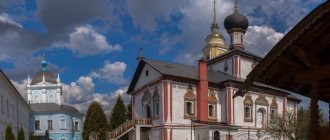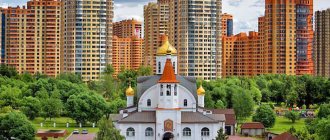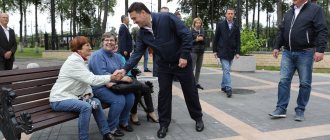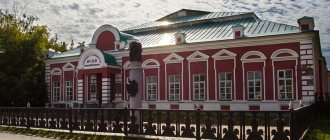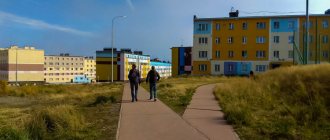| Flag of Kommunar (city) | Coat of arms of Kommunar (city) |
| A country | Russia |
| Subject of the federation | Leningrad region |
| Municipal district | Gatchina district |
| Square | 12.7 km² |
| Postal codes | 188320—188322 |
| Coordinates | Coordinates: 59°37′30″ N. w. 30°24′00″ E. Longitude / 59.625°N w. 30.4° east d. (G) (O) (I)59°37′30″ N. w. 30°24′00″ E. Longitude / 59.625°N w. 30.4° east d. (G) (O) (I) |
| Head of the Moscow Region | Vlasov Alexander Vasilievich |
| Telephone code | +7 8137165 |
| Former names | before 1918 - Village at the Rogers and Peiffer factory |
| National composition | Russians, Finns and others |
| Official site | https://kommunar.spb.ru/ |
| Timezone | UTC+4 |
| Vehicle code | 47 |
| Ethnobury | communards, communarets, communarka |
| Population | ▲ 20,270[1] people (2011) |
| OKATO code | 41 218 505 |
| First mention | November 17, 1843 |
| City with | June 28, 1993 |
| Center height | 60 m |
Plan of the Tsarskaya Slavyanka estate. 1885
Kommunar is a city (since 1993) in Russia in the Gatchina municipal district of the Leningrad region. The administrative center and the only settlement of the Kommunarovsky urban settlement.
Located in the northeastern part of the region on the Izhora River, 16 km northeast of Gatchina.
Population: 20,270 inhabitants (January 1, 2011). According to this indicator, it ranks second in the Gatchina region.
The city is the center of the pulp and paper industry.
Kommunar: the most ordinary city. A look from the outside and from the inside
Taking a minibus at the Moskovskaya metro station or an electric train in Kupchino, from the southern outskirts of St. Petersburg you can go not only to the museum-imperial Pavlovsk, Tsarskoe Selo and Gatchina. And not only in industrial-Soviet Kolpino.
With no less success, you can find yourself in a small town called Kommunar, hidden between Pavlovsk and Gatchina. What is there to do? We do not know. But it seems to us that it is worth talking not only about legendary and iconic places, but also about the most ordinary cities.
There will be no trash talk about gray high-rise buildings and the aesthetics of ruin. No. We will just tell you about the most ordinary city - what it looks like and how it lives.
View from outside
The first thing that comes to mind when visiting Kommunard is that it is a very small town. And precisely in size. The central street (Leningradskoye Shosse), which is crossed by a number of smaller streets, one of which leads to the plant. That's all. This is a typical urban-type working settlement, for some reason called a city in 1993.
Secondly, the attractions here, even by the standards of the village, are quite modest. A dozen shabby Stalin buildings (a cultural center, a post office and a dozen residential buildings), and several unremarkable monuments to war participants and workers of a local enterprise.
Oh yes, there are also a couple of wooden buildings, for example, the building of the local children's sports school, preserved from post-war times, and now surrounded by typical boxes of houses from the late Soviet period.
It looks quite unusual - the areas in the south of Leningrad looked approximately the same when their construction began on the site of former villages in the 1970s. But the memory of this in St. Petersburg was preserved only in old photographs, but in Kommunar it is present more than materially.
In general, the most important thought that does not leave you the entire time you are in Kommunar is that you have already seen all this somewhere in St. Petersburg. In Kupchino or Ozerki? In the west of Vasilyevsky Island, Ulyanka or Grazhdanka? Somewhere out there, yes. And in this similarity to everything at once, with some effort, one can find the special charm and even attractiveness of Kommunard.
Yes, it’s not hard to guess that the bulk of the city’s buildings are standard panel houses from the 1970s – 1980s. Here is something for the discerning connoisseur of standard architecture to profit from (oh yes, such people exist).
The fact is that on the streets of Kommunar are collected almost all the most famous standard house designs developed for the north-west of the USSR: from numerous modifications of the 528 series, to the legendary “ships” 1LG - 600A (yes, standard houses are different, and very ).
So if the aesthetics of the residential areas of the Brezhnev era still warms your soul, then you can even get some pleasure from visiting Kommunar.
The most amazing thing is that in such rather dull scenery a completely glorious life is taking place. There are a lot of young people on the streets, all the courtyards are occupied by children's playgrounds, and these courtyards, despite their shabby appearance, look quite well-groomed. And, leaving Kommunar, whether you like it or not, the thought creeps into your head that after all, it’s not the place that makes a person beautiful, but exactly the opposite.
A look from the inside
If you live somewhere long enough, you stop noticing the shabbyness and roughness of the space around you. Maybe that’s why not a single resident of Kommunar could call his city an urban-type settlement. Kommunard is a city, and a real one at that.
However, local youth often strive to leave their hometown and go to the “mainland” - St. Petersburg. Since the 90s, it has been the custom that Kommunar is a kind of buffer zone between the lack of visible opportunities and high hopes for the future.
On the one hand, leaving Kommunar, many strive to say goodbye to its almost eternal queues at the post office, in the clinic and other government institutions, the far from the most harmonious architectural environment and the proximity of pulp and paper industry enterprises (there is no such thing in St. Petersburg, yeah).
But, on the other hand, they immediately part with many modest delights of a small town: the opportunity to play tennis, swimming or fitness at the local sports complex for little money, good and relatively cheap Internet, or the opportunity to buy freshly baked bread in a small store in the city center right on one of the main stops.
Kommunard is really similar to most of the St. Petersburg outskirts. But its small size and small population make the city not so much Grazhdanka, Ozerki or Kupchino, but rather their model in miniature. So you can really see a lot in common between Kommunar and the outskirts of St. Petersburg, but there are also many local features.
For example, in the north of the city, or, in local parlance, “in the nut,” there is a local shawarma establishment and a vape shop. There are other “meeting places”, for example – fashion stores that solve the need of young people for new clothes.
The tradition of companies (literally) “sitting on the pipes” (or “on the pawn”) of the city’s heating system is no longer so relevant, but is still alive. After sunset, the opportunity to explain the color of shoelaces, Martins, or choice of hairstyle is as high as on the streets of Kupchino or Vesyoly Settlement.
In recent years, Kommunar has changed noticeably. Ten years ago it was really hidden somewhere between Pavlovsk and Gatchina, but now everything is somewhat different. City services, whenever possible, improved the houses and adjacent courtyards, and repaired a large number of roads. New cafes, shops, shopping malls and even a cozy cafe at a flower shop have appeared, where you can while away the time with coffee and dessert while reading books. The commune lives and develops, and everything will be fine for him.
Artyom Shipunov, Elena Tcherezova
If you find an error, please select a piece of text and press Ctrl+Enter.
Demography
Population changes from 1959 to 2011:
Commuting migration is common among city residents: about 6,000 city residents go to work or study in St. Petersburg.
The unemployment rate is 0.67%.
The demographic situation is characterized by natural population decline.
Honorary residents of the city of Kommunar
- Ivanov Anatoly Ivanovich (2003)
- Ogurskoy Yuri Borisovich (2004)
- Sergachev Valery Nikolaevich (2006)
- Nikolaev Dmitry Vladimirovich (2009)
- Ilyin Vladimir Ivanovich (2007)
- Kuzmenkova Liya Vasilievna (2005)
- Golod Yankel Beniaminovich (2004)
Move to Kommunar
Since the 2000s, the local population in the city of Kommunar, Gatchina district, Leningrad region, has grown by 25%. Factors and vectors of development of this territory were found out by Construction Weekly.
According to Ekaterina Teider, head of development and territorial development projects at Becar Asset Management Group, in recent years developers have become more active in developing the southern regions of the Leningrad region. Previously, this direction was less in demand than the traditionally popular north. “Two trends are observed in the south: the development of large regional centers, such as Gatchina, and free areas for individual residential development in the format of private houses, cottages and townhouses,” said Ekaterina Teider. The Communard was no exception in this regard. The construction of housing and social infrastructure in Gatchina also affected Kommunar, experts are sure.
Popularity is growing
“Kommunar was in the past a small industrial town with a city-forming paper mill, and today it is one of the leading municipalities in the Gatchina region,” says Vera Pyzhova, head of the Kommunar city administration. – This is evidenced by demographic growth indicators, as well as the pace of housing construction. Today, 22 thousand people live in the city, which is 4 thousand more than in 2010.” According to Svetlana Moskovchenko, head of the analytics department at Knight Frank St Petersburg, in total, since the 2000s, about 65 thousand square meters have been built in Kommunar and the surrounding area. m of housing. These are apartments in high-rise buildings, cottages and townhouses. Today, the city has several residential projects at various stages of implementation in two districts of the city. Thus, on a site with an area of 20 hectares, a project for the integrated development of the territory is being implemented - the Novo-Antropshino residential complex. These are houses ranging in height from two to five floors, a kindergarten, and public and business zone facilities. Separately, space will be allocated on the territory of the residential complex for open parking lots with a total capacity of 170 parking spaces. The project will be implemented in two stages, which are planned to be fully completed by 2022. Another project in Kommunar is being implemented by the group. This is the “City of Childhood” residential complex, which includes the construction of three-, six- and eight-story buildings with a school and kindergarten. All buildings of the residential complex are planned to be completed by 2022. The project is being implemented in three stages. Leader LLC, which is building the Nadezhny residential complex, also showed interest in the city.
Roads and spectacles
The cost of housing in Kommunar is significantly lower compared to the more popular northern suburbs of St. Petersburg. Rusland SP partner Andrey Boykov said that it can vary between 45 and 65 thousand rubles per square meter. The average price of a studio in a new building is from 1.2-1.4 million rubles. “In Kommunar, mostly economy-class housing is being built. Demand is primarily driven by low acquisition prices. Although, of course, there are adherents of this location. These are mainly people living in the areas of Gatchina and Pushkin,” Andrei Boykov shared his opinion. Speaking about the main advantages of the territory, experts identified two main factors: price and proximity to St. Petersburg. “New housing in Kommunar is in demand due to a combination of cost and location factors,” explains Ekaterina Teider. – The cost is significantly lower than the prices for apartments in St. Petersburg and Gatchina, while the city is located in a fairly comfortable zone of transport accessibility: both Gatchina and St. Petersburg are 35-40 minutes away. This is a fairly comfortable time to get from home to work. The development of transport infrastructure in the southern part of the Leningrad region, the expansion of roads and the construction of new transport interchanges also have a positive effect.” However, not everyone is satisfied with the city's transport accessibility. Svetlana Moskovchenko does not consider it successful. Lyubava Pryanikova, senior consultant of the consulting department of Colliers International in St. Petersburg, shares the same opinion. Experts attribute the lack of schools, kindergartens and shops in the city to the disadvantages of this territory. Ekaterina Teider is sure that the level of social and service infrastructure is now relatively low. So far this is compensated by the infrastructure of Gatchina and St. Petersburg. “In addition, the issue of reconstruction of treatment facilities, which are operating at maximum capacity, is now urgent. It is also necessary to develop recreational facilities for our residents in the city,” Vera Pyzhova listed. A new project, which was considered by members of the Leningrad Region Urban Planning Council in April of this year, should bring diversity to the lives of local residents. On an area of 20 hectares, she decided to build a residential quarter, an active recreation park, sports and shopping clusters. Local authorities hope to implement this project. The City Council participants approved its sketch taking into account the comments made.
Opinion:
Lyubava Pryanikova, senior consultant at Colliers International in St. Petersburg:
– Kommunar is a small industrial city with difficult transport accessibility and the absence of such attractions as parks, nature reserves, and reservoirs. These factors significantly reduce its attractiveness for living and, accordingly, for the construction of new housing. In Kommunar, isolated projects are being implemented that cannot boast of successful sales. Buyers of apartments in these projects are primarily focused on the low cost of housing.
Veronica Adamyuk, executive director of Leader LLC:
– Future new residents of Kommunar are attracted by its combination of the charms of country life and city comfort with developed infrastructure and excellent transport links. Getting from Kommunar to St. Petersburg and the nearest palace suburbs (Gatchina, Pavlovsk, Pushkin) is not difficult. In addition, there is a lot of natural beauty here. In one of these places, on the banks of the Izhora River, the Nadezhny residential complex is being built. The name speaks for itself. The eight-story, three-section residential building is being built from high-quality prefabricated reinforced concrete, produced using modern Finnish equipment under strict technological control. The building will have a bright graphic facade, which will give the house an aesthetic and modern look. This is exactly what the city still lacks – brightness and style. The Nadezhny residential complex has 176 apartments, from studios to 3-room apartments. When designing, we tried to zone the apartments according to types in order to create a comfortable living environment. We plan to continue to implement our projects in Kommunar, to promote the development and transformation of Kommunar, since people who sincerely love their city live here, and the local authorities are constructive and aimed at creating a favorable investment climate.
By the way:
The city of Kommunar participates in the regional program for the resettlement of emergency housing stock. During its implementation, residents of 30 dilapidated and dilapidated houses moved into comfortable housing. By 2022, it is planned to resettle 9 more emergency houses, the Kommunar City Administration reported.
History[edit]
Historical image of a paper mill
It was founded in the 1840s by the landowner Countess Yulia Samoilova as the Count's Slavyanka
(Count Slavyanka).
[2] In 1846 it was purchased by the government and renamed Tsarskaya Slavyanka
(Tsarskaya Slavyanka).
[2] Before 1918, it was also known as the Rogers and Peiffer Mill Village. In 1918 it was renamed Krasnaya Slavyanka
. [11] At the beginning of the 20th century, it was part of the Tsarskoye Selo district of St. Petersburg governorate [12] (renamed in 1913 to the Petrograd province, in 1924 - to the Leningrad province). On November 20, 1918, the district was renamed Detkoselsky. [12] On February 14, 1923, the Detkoselsky and Peterhof districts were abolished and merged into the Gatchina district with the administrative center in Gatchina. [12] On February 14, 1923, Gatchina was renamed Trotsk, and Gatchina Uyezd was renamed Trotsky Uyezd [13] in honor of Leon Trotsky.
On August 1, 1927, the districts were abolished and the Trotsky district was formed with the administrative center in the city of Trotsk. The akimats were also abolished, and the district became part of the Leningrad Okrug in the Leningrad Region. The village became part of the Trotsky district. [ citation needed
] On August 2, 1929, after Trotsky was deported from the Soviet Union, Trotsk was renamed Krasnogvardeysk, and the district was renamed Krasnogvardeysky. [14] On July 23, 1930, the okrugs were also abolished, and the districts were directly subordinated to the region. On January 28, 1944, Krasnogvardeysk was renamed Gatchina, and the district was renamed Gatchinsky. [14]
Kommunar received the status of an urban settlement on October 8, 1953 [14], and the status of a city on June 28, 1993. [3] In 1996, the city held a popular vote on whether it should become a regional city. However, in 2010, the administrative division of the Leningrad region was agreed upon with its municipalities, and Kommunar again became a city of district significance. [15]
Links[edit]
Notes[edit]
- ^ abcdef Provincial Law No. 32-oz.
- ^ a b c Kommunar, city (in Russian). Encyclopedia of the Leningrad Region. Retrieved February 28, 2014.
- ^ a b History (in Russian). Official portal of the city administration of Kommunar. Retrieved February 28, 2014.
- ^ a b Federal State Statistics Service (2011). All-Russian Population Census 2010. Volume 1 [All-Russian Population Census 2010, vol. 1]. All-Russian Population Census 2010 [All-Russian Population Census 2010] (in Russian). Federal State Statistics Service.
- "26. The size of the permanent population of the Russian Federation by municipalities as of January 1, 2022". Federal State Statistics Service. Retrieved January 23, 2022.
- ^ abcd Law No. 113-oz.
- "On the Calculation of Time". Official Internet portal of legal information
. June 3, 2011. Retrieved January 19, 2022. - Post office. Information and computing center of OASU RPO. ( Post office
).
Search for postal service objects ( postal Search for objects
) (in Russian) - ↑
Federal State Statistics Service of Russia (May 21, 2004). The population of the Russian Federation, cities of the Russian Federation as part of federal districts, urban settlements, settlements, settlements, settlements is 3 thousand or more people. [Population of Russia, its federal districts , subjects of the Federation, districts, urban settlements, rural settlements - administrative centers and rural settlements with a population of more than 3000 people] (XLS). All-Russian Population Census of 2002 [All-Russian Population Census of 2002] (in Russian). - All-Union Population Census of 1989 Population of Union and Autonomous Republics, Autonomous Regions and Districts, Territories, Regions, Urban Settlements and Village District Centers [All-Union Population Census of 1989: Current Population of Union and Autonomous Republics, Autonomous Regions and Districts, Territories, Regions , districts, urban settlements and villages performing the functions of district administrative centers]. All-Union Population Census of 1989 [All-Union Population Census of 1989] (in Russian). Institute of Demography of the National Research University: Higher School of Economics [Institute of Demography of the National Research University: Higher School of Economics]. 1989 - via Demoscope Weekly
. - Secrets of the Count (Tsar) Slavyanka (in Russian). City of Pushkin.INFO. Retrieved February 28, 2014.
- ^ abc “Archival copy” Tsarskoye Selo district (1917 - November 1918), Detskoselsky district (November 1918 - February 1923) (in Russian). System of classifiers of executive bodies of state power of St. Petersburg. Archived from the original on May 19, 2013. Retrieved 28 February 2014.CS1 maint: archived copy as title (link)
- “Archival copy” Gatchina district (February 1923 - August 1927) (in Russian). System of classifiers of executive bodies of state power of St. Petersburg. Archived from the original on March 4, 2016. Retrieved 28 February 2014.CS1 maint: archived copy as title (link)
- ^ abc "Archival copy" Trotsky district (August 1927 - August 1929), Krasnogvardeysky district (August 1929 - January 1944), Gatchina district (January 1944) (in Russian). System of classifiers of executive bodies of state power of St. Petersburg. Archived from the original on December 3, 2013. Retrieved 28 February 2014.CS1 maint: archived copy as title (link)
- Report on the work of the committee for interaction with local government of the Leningrad region in 2010 (in Russian). Committee for Press and Public Relations of the Leningrad Region. Retrieved February 28, 2014.
- “Archival copy” Mass grave of Soviet soldiers who died during the Civil and Great Patriotic Wars (in Russian). Ministry of Culture of Russia. Archived from the original on February 28, 2014. Retrieved 11 February 2013.CS1 maint: archived copy as title (link)


